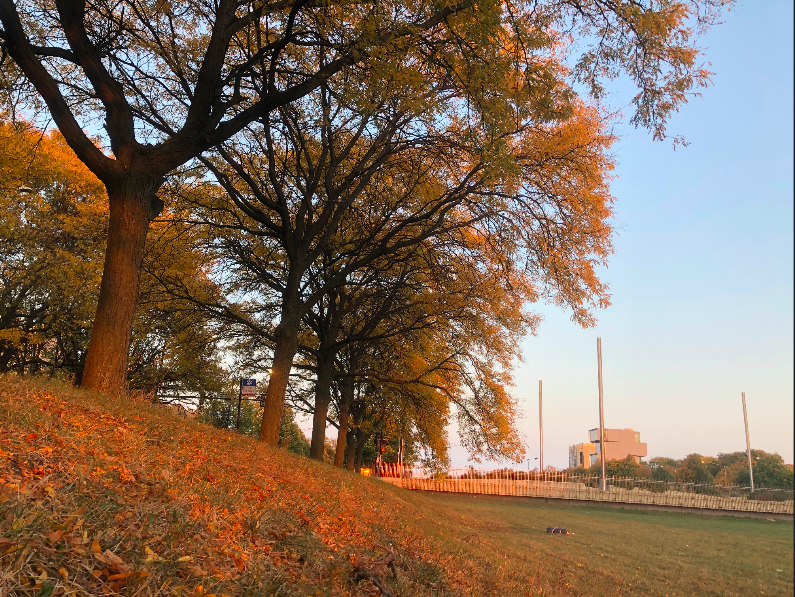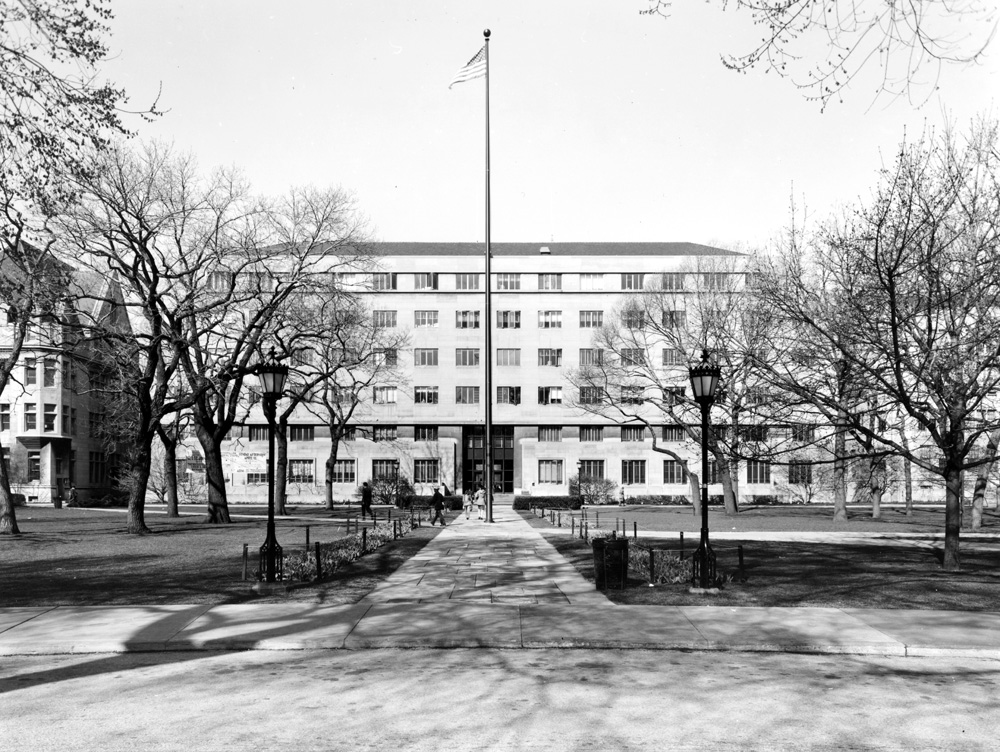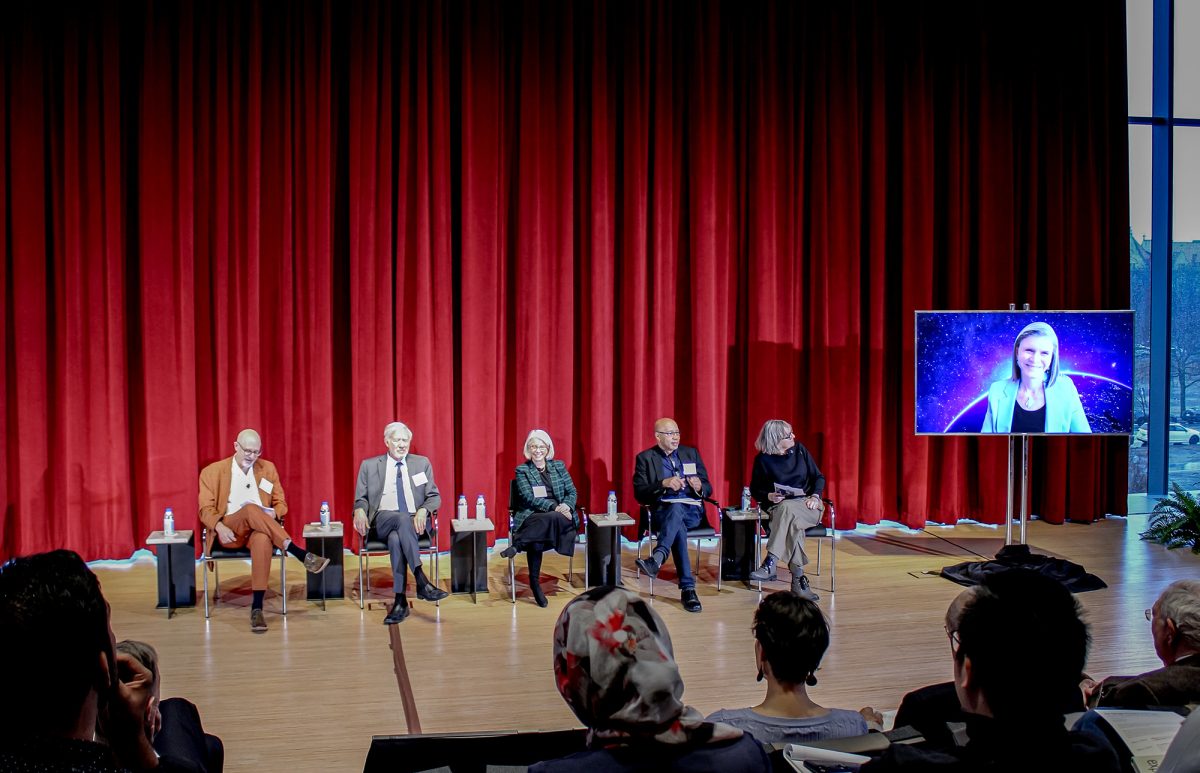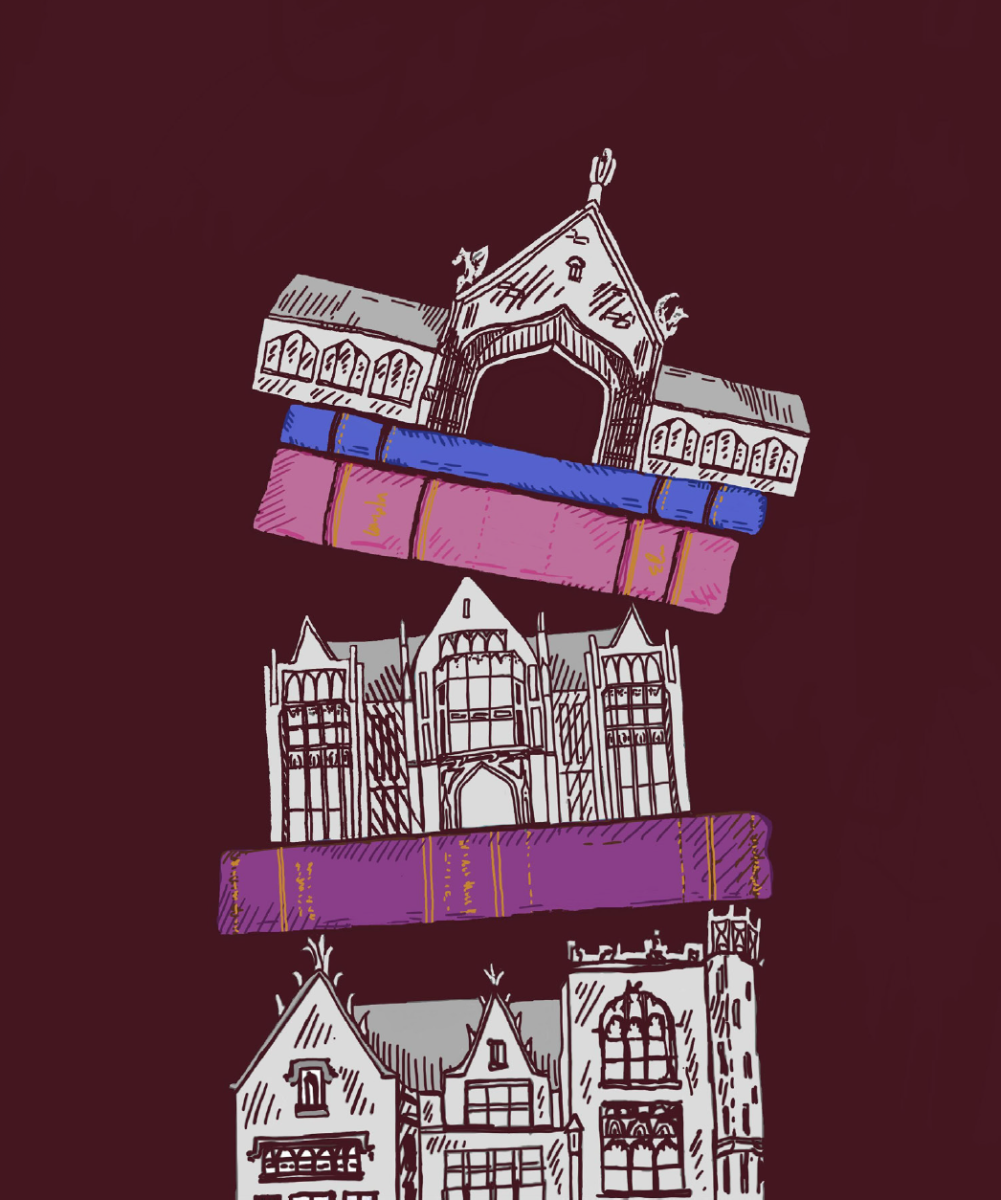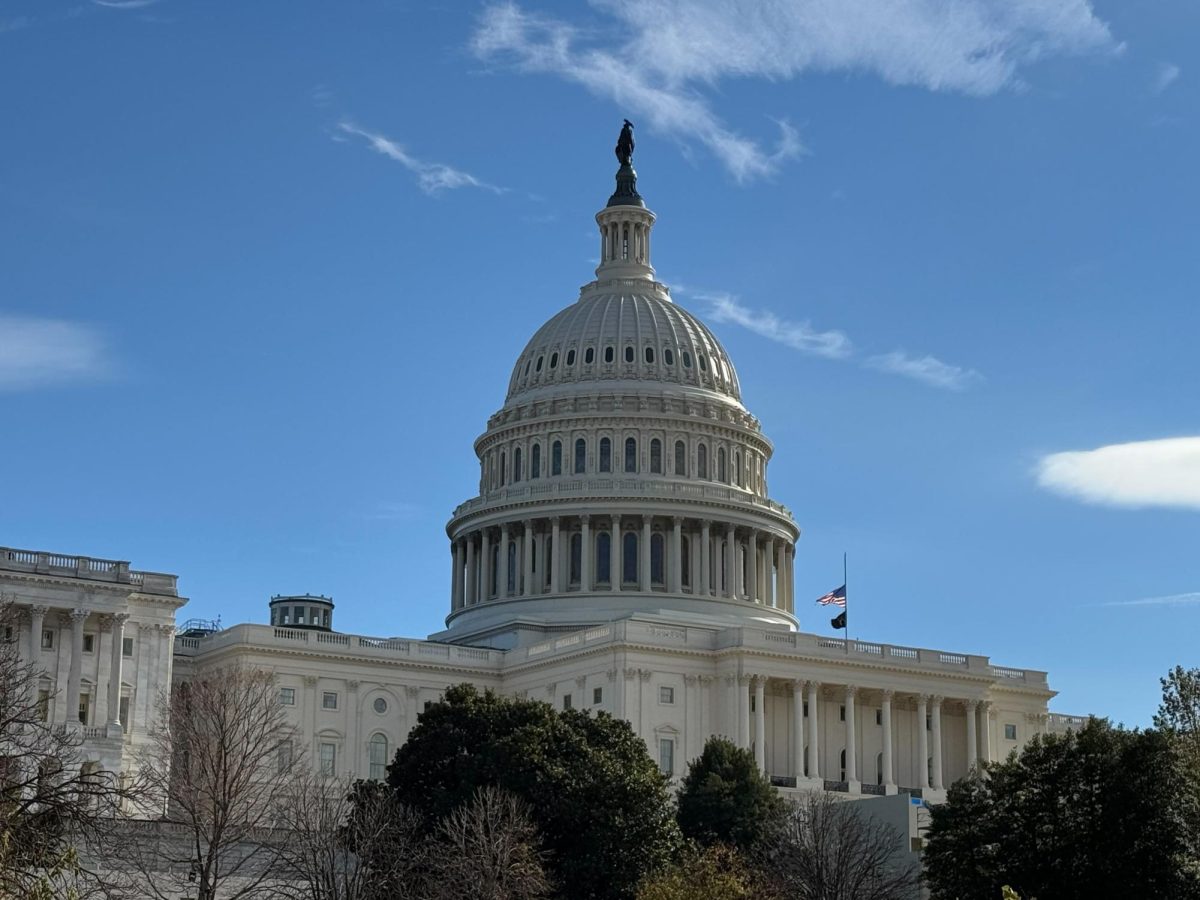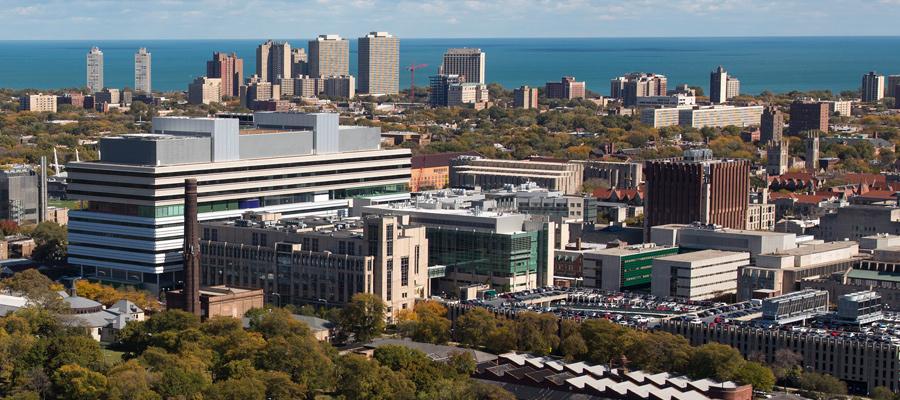A century ago, a bur oak sapling was planted next to Bartlett Gymnasium.
The tree, over the course of its lifetime, sees the University of Chicago through a timespan longer than any individual human does. Its middle age sees the construction of Regenstein Library, its senior years the transformation of the neighboring gymnasium into a dining commons. It eventually towers above Max Palevsky Residential Commons and Bartlett Dining Commons, providing a sanctuary for those who come to rest below its branches.
Years unfurl into decades, and when the tree has 100 rings, a group of researchers—mask-clad and six feet apart—gather to assess the old oak, gnarled and wide-crowned. They marvel at the tree’s grandeur, surrounding it with outstretched arms; it takes the wingspan of two of the researchers, plus that of one small child, to fully encircle its trunk.
The tree tells them a story of late adulthood tinged with illness. It has a wound in its trunk, caused by a canker disease, and the humans seek to measure the oak’s remaining strength. The test takes just a few hours, and it is determined that the tree has years more to live. But even at this moment, in the tree’s late adulthood, the old oak is a newcomer to the region; its ancestors, too, are new arrivals. This bur oak was preceded by generations and generations of trees, in a time when the landscape would be near-unrecognizable to today’s onlooker.
Twenty thousand years ago, Chicago was encased in 3,000 feet of ice—a glacier the height of 40 mature bur oaks. Traces of ancient tree pollen suggest that more diverse floral environments began to emerge as the ice receded. Seventeen thousand years ago, the region was dominated by spruces, trees adapted to growing in cold climates, and the forests were still inhabited by mastodons, woolly mammoths, and other large mammals. As the climate became warmer over the millennia, however, marsh-loving black ash trees became the primary species, and humans succeeded large mammals as the region’s apex predators.
The land which eventually became the University of Chicago, too, looked very different from how it does today. Because it is situated on what is known as a lakefront marsh ecosystem, the campus was swampy and prone to flooding, which remains an issue even today. Its infertile soil was lacking in nutrients, so the landscape was scattered with shrubs.
Human culture in these areas developed over the next few thousand years; in Chicago, this included the indigenous tribes of the Council of the Three Fires—comprised of the Chippewa, Ottawa, and Potawatomi Nations—as well as the Miami, Ho-Chunk, and Illinois Nations, among others. While these cultures were as diverse as they were numerous, many went to great lengths to stabilize the natural ecosystem and exercised a keen awareness of their effect on the environment.
That is not to say that they left no trace; many of their large-scale ecological practices had a profound impact in creating the landscape we see today. Among the most influential of these practices was the use of fire to manage ecosystems. Fire-setting could have served a number of purposes. It may have improved the ease of spotting game, ease of movement, or served as part of another ritual practice. But it also played an important role in stabilizing the ecosystem.
“To preserve tallgrass prairie, you have to burn it,” Eric Grimm, a paleoecologist who has studied the history of Chicago’s natural environment, told The Maroon in an interview. “If you don’t burn it, it’ll be overtaken by woody plants, and by introduced European species…. [Regular burning] maintains the vegetation that was native to Illinois.”
The benefits of this practice were manifold. In his essay “Native Americans and the Environment,” historian David Rich Lewis writes that the fires neutralized soil acidity and warmed the earth, which sped the germination of new forest flora. Periodic low-burning fires also reduced the risk of naturally occurring uncontrolled fires, as the accumulation of dry materials absent these fires turns forests into tinderboxes.
But humans’ role in the Chicago environment changed rapidly at the turn of the 19th century, when Europeans forcibly displaced the native populations that had been living there for centuries.
Decades before Smokey Bear popularized the notion of aggressive fire suppression—at the expense of forest ecological stability, forest researchers have since written—the U.S. Forest Service outlawed native fire-setting on the grounds that the fires destroyed marketable timber materials. This was codified in the 1935 “10 a.m. policy,” which mandated that all fires be under control the morning after they were set.
In the debate over forest management can be seen European colonizers’ attempt to establish cultural hegemony on the so-called “frontier.” Author and fire historian Stephen Pyne has argued that European opposition to the practice was also rooted in the view that fire-setting is a mark of cultural primitivism.
The long-held policy of fire suppression has had lasting effects, this year’s raging wildfires in California among them. But it is also slowly changing the composition of modern-day oak woodlands, Grimm said. Thick-barked oak trees are resistant to fire, unlike relatively sensitive maple trees. As a result, “if a forest just sits there and isn’t burned or disturbed, the maples will eventually take over,” he said.
Another large-scale European ecological practice was the draining of naturally occurring swamps. The Swamp Land Act of 1850 promoted the draining of wetlands in Illinois and reclamation for settlement and development. Gerould Wilhelm, a botanist and co-author of the compendium on local plants Flora of the Chicago Region, said that the practice of draining wetlands permanently debilitated the environment.
Soil in the Midwest has simply been “killed out” by industrial-scale tillage, Wilhelm said. The draining of wetlands created a harmful positive feedback loop: With no water on land, no water can be evaporated to form clouds; in turn, there is no rainfall to rehydrate the land.
Draining land also makes the soil more sensitive to fluctuations in temperature. Water has a relatively high specific heat capacity, meaning that a lot of heat is required to raise the temperature; this allows it to stabilize the temperature of moist soil. But dry soil lacks this temperature control.
“When [organic matter] is gone, and the soil is just sitting there, it just cooks, or it freezes,” he said. “It would be like if you had a third-degree burn on your body; that surface tissue is dead. And if you had third-degree burns on 95 percent of the body, you can imagine the trouble you’re in.”
Wilhelm is intimately familiar with the scale of human impact on the environment, as he devised the Floristic Quality Assessment (FQA), a measure of the integrity of natural ecosystems. The FQA works by determining the area’s average “coefficient of conservatism” (C-value), or how likely it is that its flora are native to the region.
Untouched natural areas, which Wilhelm said includes the Chicago region prior to European arrival, have an average C-value of 5.5. Nowadays, however, C-values in Chicago range from 0 to 2. This metric doesn’t even account for the fact that vast swaths of concrete urban space are totally devoid of plant life, Wilhelm said.
Botanists and landscape planners at UChicago are also conscientious of the loss of native plants. Manager of Campus Environment Design Kathleen Golomb is committed to preserving these native species by planting trees that are native to the area on campus.
“We work with nurseries; we usually procure our trees within 250 miles to make sure they’re most adaptable to our climate,” said Golomb.
The landscaping department visits nurseries and fields in Wisconsin, Illinois, and Indiana to best understand what trees will be most adaptable to the climate in Chicago, considering factors such as species diversity, resistance to pests, and the trees’ ability to thrive in warmer climates.
Despite such efforts to soften the blow of humanity’s impact on the environment, anthropogenic land cover had already threatened natural life in Chicago. “Habitat fragmentation,” or the subdivision of natural ecosystems, is one of the main mechanisms of this process. This has particularly harmed birds, many of which need bigger expanses of woodland, and likely caused a large-scale drop in bird diversity throughout Illinois, Grimm said.
Climate change is expected to take a tremendous toll on a variety of Chicago-area flora and fauna. Already, warming temperatures have caused species to move northward to stay within temperature ranges to which they are adapted—causing such exotic creatures as armadillos to turn up in Illinois, Grimm said. Without a contiguous habitat, it will be difficult for animals to perform this necessary migration.
Likewise, Golomb and the rest of the campus planning and sustainability group in Facilities Services at UChicago are already accounting for the effects of climate change on campus ecology. Specifically, the group has started selecting trees and shrubbery that can survive in warmer climates, anticipating a gradual increase in Chicago’s temperature.
“While it’s in our care, we want to really focus on the strength of [the campus], the health of it, and, as always, planning for the future,” Golomb said.
The loss of biodiversity is also a concern among ecologists at UChicago and around the world. Beyond the inherent tragedy in decreasing life’s richness, the climate forecast makes this doubly concerning.
“As species get reduced in numbers, we’re losing some of the genetic diversity that those species have,” Wilhelm said. “The fact that we’ve lost this diversity has made them less able to adapt.”
In the early 20th century—before climate change was viewed a major concern—the UChicago campus was organized with a mainly aesthetic purpose. Streets were lined with trees of the same species, Golomb said, bringing about an air of unity and symmetry to the environment. However, over the last 20 years, planners of the campus have come to realize that planting the same trees in one area, a practice called monoculture, is severely unsustainable and detrimental to the health of the campus’s natural environment.
While the aesthetic appeal of campus is still taken into consideration, Golomb emphasized that it is most important to plant for diversity. If a disease or pest were to infest a certain species, the problem would be addressed more easily and effectively as the variance in species across campus would block the pest or disease from rapidly spreading.
“What we’ve known and learned from the past with chestnut blights and Dutch elm disease is that we have to get away from these monocultures of tree plantings,” Golomb said. “We might not have those specific stately avenues that you might have seen in the ’40s, ’50s, ’60s, even back in the ’30s, but knowing what we know now, it’s most important to plant for diversity."
One thing is for certain: The natural equilibrium prior to humans cannot be returned to its original state. Even areas that humans attempt to restore to their original biodiversity rarely reach above a 3 on the FQA scale, Wilhelm said, and they never regain their original rating of 5.5.
While Golomb and her department spend $20,000 a year repopulating the campus with new trees, she emphasized that no amount of restoration efforts can ever fully restore the original quality of undisturbed trees that for centuries have existed on the land that became UChicago’s campus.
Campus “will change tremendously, but with that the protection of existing trees is extremely important,” she said. Inevitably, “we will lose trees due to construction; however, mature trees should take precedence. It’s not the same to replace a tree that’s a thousand years old with a tree that’s two years old.”
Perhaps a lesson can be drawn from our arboreal neighbors. When trees have a wound or infection, they don’t heal, as humans do; rather, they form a wall of tissue around the harmed area to prevent it from spreading to the rest of the tree. Only if this wall is compromised will disease be able to advance. Humanity’s impact on the natural environment cannot be undone, but its negative effects can be mitigated, and a new equilibrium can be devised.
In the meantime, a row of vivacious katsura trees lines the west side of Max Palevsky East, a singular Persian parrotia stands tall near Swift Hall, and a magnificent bur oak unfurls its branches across the side of the Bartlett Gymnasium. Under their boughs, Golomb feels at home; and her appreciation for nature has given rise, unmistakably, to tenderness.
“I really think that you create this relationship with campus, and you will find your little hidden gems—the place that you return to over and over again—throughout your campus career,” Golomb said. “These little pieces of campus that you carve out as your own.”



